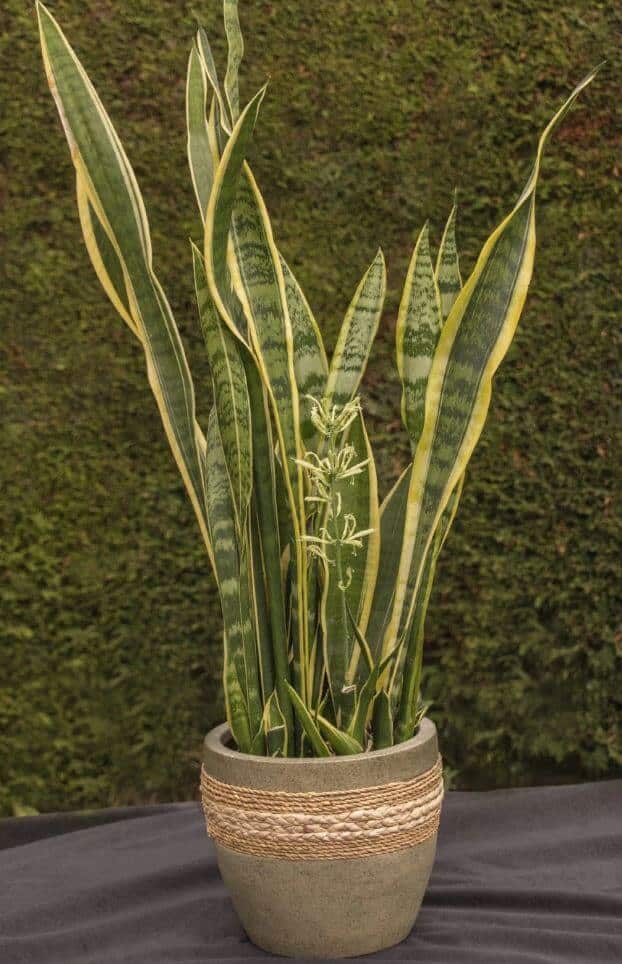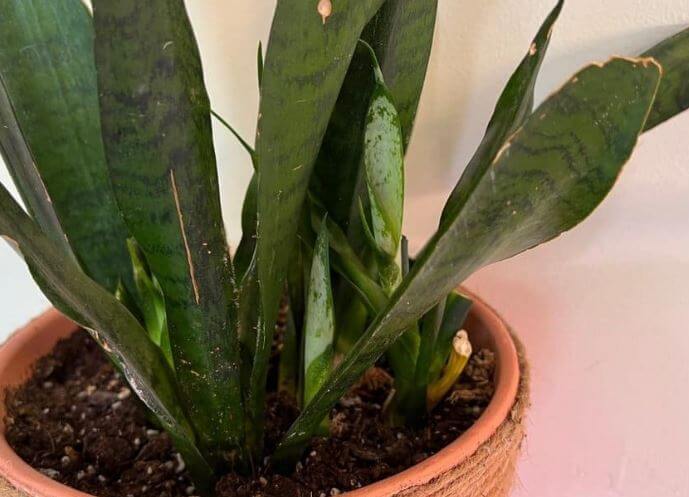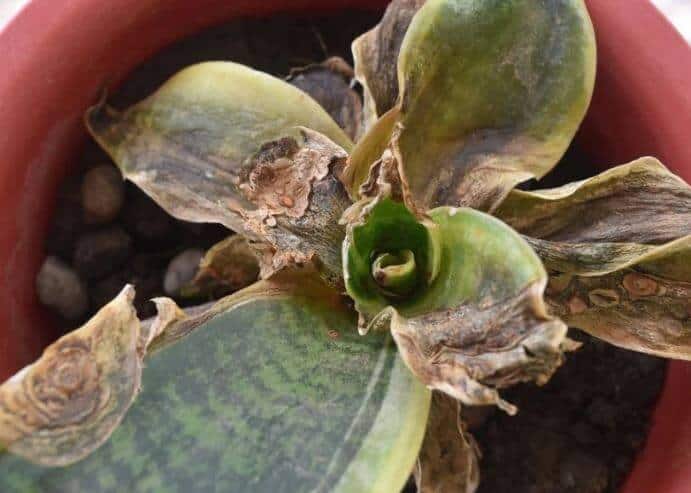Last Updated on August 31, 2023 by a Friendly Gardener
Snake plants are incredibly popular houseplants both for their sculptural decorative quality and for their ease of care. Among other popular names, these plants are also known as the Mother-in-Law’s Tongue plant. Botanically named the Sansevieria until recently, this botanical classification was modified to Dracaena, although most people will recognize the traditional classification.
Snake plants are considered indestructible as houseplants. They are succulents that ask very little of their plant parents. Nonetheless, they are susceptible to a variety of health issues that can leave plant parents wondering ‘Is my snake plant dead?’
A Dying Snake Plant

If you have a dying Snake plant, it’s critical to identify the cause to have any chance of saving it. Among the most common reasons for a failing snake plant are extreme temperature exposure, root rot, fungal infections, and pest infestations. These problems can easily be identified and treated if done so early on. The quicker you intervene, the greater the possibility of saving your plant.
Snake Plant Health Issues

Root Rot
The most common threat to a Snake plant’s health is root rot. This is usually due to overwatering particularly in cooler seasons. Roots are left sitting in water and they drown because they do not have adequate oxygen. Or they may become ill because of the development of fungi in soggy soil. Waterlogged soil is the primary cause of fungi such as Fusarium, Phytophthora, Pythium, and Rhizoctonia developing in soil beds and then spreading to root systems. Light-colored roots will turn brown and mushy and begin to fail as they are no longer able to absorb necessary nutrients.
A major challenge with identifying root rot is that this infection occurs out of sight below the soil’s surface. If the plant’s container does not have adequate drainage, death can occur in a period as short as ten days. Snake plants must be cultivated in well-draining soil mixtures and pots that guarantee drainage.
Root rot, as stated will attack the root ball first, turning healthy roots brown or black and mushy in texture. As the infection takes hold, leaves will begin to yellow, wilt, and become mushy. If the infection has spread to the leaves, the plant may be beyond saving.
What to Do
Initially, you need to remove the plant from soggy soil and repot it in fresh soil. It’s best to use a soil blend that is formulated for succulents and cacti. Before replanting, trim any infected roots from the plant and rinse the remaining healthy roots and treat with a fungicide like Neem oil.
If the plant is severely infected, cut away only healthy parts for replanting. If the snake plant is dying, take healthy cuttings for the propagation of a new plant.
Water these plants sparingly. Wait until approximately three inches of the soil bed is dry. In comfortable and cooler climates, you may only need to water a snake plant once every month or two. Snake plants do have some drought tolerance as succulents, so they can manage as much as three weeks without watering even in warmer temperatures.
Environmental Temperatures

Snake plants are native to western Africa, so they like warm environments. If they are exposed to very cold temperatures, the foliage cell walls will be harmed. This damage inhibits both nutrients and water flowing from the root system to arrive, so the plant dies of thirst. Yellow, mushy foliage or leaves with scarring may appear.
What to Do
In these cases, it’s best to prune snake plant dead leaves. Do not trim healthy foliage as you will be stressing an ill plant even more. Try to keep your Snake plant in a spot where daytime temps measure in the 60° to 80° F range. Nighttime temps should not fall below 55°F or measure above 70° F.
Pest Issues

Two of the more common houseplant insects that may torment your snake plant are spider mites and mealybugs.
-
Mealybugs
These pests can be spotted as cottony deposits on leaves where they deposit eggs often close to the base. They are sap suckers that feed on the plant’s fluids excreting sticky honeydew on the foliage. Honeydew encourages the development of sooty mold. Severe infestations will cause leaves to curl, yellow, and drop.
What to Do
Remove mealybugs manually from snake plant leaves, then clean leaves with a cotton ball dipped in rubbing alcohol. Do an alcohol test on a small foliage spot to be sure it will not damage leaves further. Insecticidal soap or neem oil are also options. Examine your plant weekly and quarantine infected plants to prevent the spread.
-
Spider Mites
Spider mites generally make their home on leaf undersides. They, too, are sap suckers. These pests are highly prolific and slight infestations can turn severe in no time wreaking havoc before symptoms are apparent. Once they harm plants, leaves begin to discolor or turn yellow and webbing may be visible on the plant.
What to Do
Spray your plant with insecticidal soap and then wipe the foliage with a soft cloth. In the case of severe damage, all affected leaves should be pruned. One way to contrast spider mites is to maintain higher humidity levels as these pests like dry warm climates.
Fungal Infections

Fungal infections to be aware of include Southern Blight and Red Leaf Spot.
-
Southern Blight
Caused by the parasitic fungus Sclerotium rolfsii, it has been known to affect more than 500 plant species and be fatal. This fungus thrives in moist and warm environments. When Southern Blight strikes, white patches on leaves will appear. These patches will then turn dark brown. Snake plant leaves will have wet, white thready growths and begin to wilt.
What to Do
Fungicides are the recommended treatment after you have removed infected tissue. Try neem oil before opting for chemicals. Good airflow around your plant will help and use new soil when repotting. Also, inspect thoroughly any new plants you bring home.
-
Red Leaf Spot
Drechsiera Erythrospila causes the fungal infection Red Leaf Spot. It is common during the warmer seasons of spring and summer. These fungi attack when their spores find hospitality on a wet leaf. Red spots develop with tan-colored centers. Gradually, spots will join creating large wet lesions on foliage.
What to Do
Prune affected leaves. Small infections can be treated with fungicides that are sulfur, or copper-based.
How to Trim Dead Snake Plant Leaves
Snake plants, like all houseplants can benefit from the occasional pruning. Ideally, pruning should be done in the spring and summer seasons as in the fall and winter your plant will be dormant.
When trimming your snake plant, never remove more than one-third of the entire plant in one pruning session. Prune using sterilized sharp gardening scissors or a thin knife. Cut off problem leaves close to the plant base, just above the soil bed surface. After you have trimmed, avoid watering for about five days.


